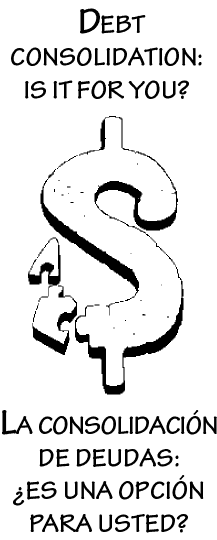Debt Consolidation
Is It for You?
A fact sheet that explains how to consolidate your debts so that you only have to make one monthly payment. Discusses the advantages and possible problems with debt consolidation.

This document may also be available in the following languages: Chinese, English, Korean, Russian, Spanish, and Vietnamese, among others. An Adobe Acrobat (pdf) file (optimized for printing) may also be available in some or all of the above languages. To see what languages and formats this document is currently available in, please check our online Multilingual Library.
Note: Last revision 1992. Use this information as a general guide only; consult with a local consumer group for laws specific to your state.
What is Debt Consolidation?
For some people with credit problems debt consolidation may be an answer. Debt consolidation is borrowing enough money from one lender to pay off all your debts. When you consolidate:
- You make only one payment each month, to the new lender.
- You will usually pay out less money each month.
- You usually pay more money in finance charges to consolidate debts.
- You make payments longer.
Before Consolidating
Before you decide to consolidate your debts, look at your other choices:
- Talk to your family members about the problem. See if you can lower expenses or raise income.
- Seek financial counseling. You can go to a credit counseling service. They may know a solution you have not thought of.
- Call your creditors to see if you can work out some change in monthly payments that will ease the pressure. The creditors may be willing to adjust payments.
After You Decide
If you do decide to consolidate your debts, shop around. There are different places you can go, such as banks, credit unions, and finance companies.
Before you choose whom you will get the loan from, find out the following information from each place:
- The charge for the service.
- The annual percentage rate (APR).
- The amount of your monthly payments.
- How long you must make payments.
- What the total amount is that you will pay.
- What happens if you miss a payment.
- What happens if you are late making a payment.
Potential Problems
Making only one payment a month may make you think you are better off than you actually are. You may be tempted to buy something else on credit, and before you know it you could have an even worse problem: too many bills with too little income.
Copyright, Credits & Usage
© Copyright 1992 Home Economics Department, Institute of Food and Agricultural Sciences, University of Florida, Gainesville
Funded by the National Coalition for Consumer Education and AT&T Consumer Credit Education Fund
Electronic publication produced by Consumer Action
Electronic publication funded by AT&T Universal Card
Published / Reviewed Date
Published: April 01, 1992
Download PDF
No Download Available
Sponsors
Filed Under
Copyright
© 1992 –2024 Consumer Action. Rights Reserved.



